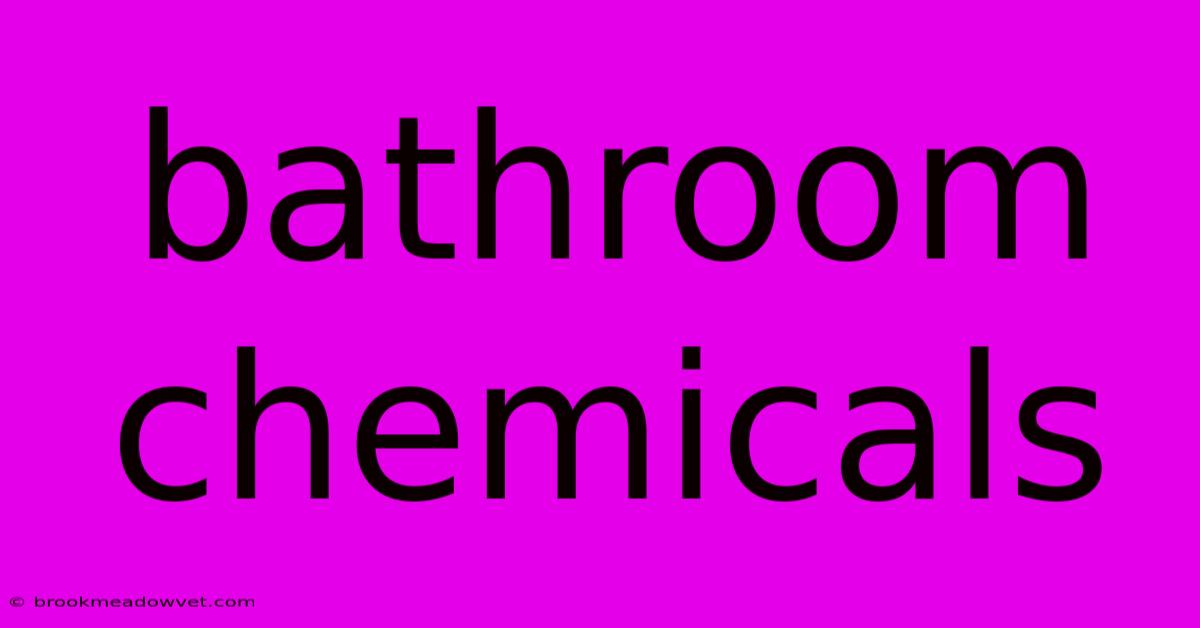Bathroom Chemicals

Table of Contents
Understanding Bathroom Chemicals: A Guide to Safe and Effective Cleaning
Maintaining a sparkling clean bathroom requires the use of various chemicals, but understanding what you're using is crucial for both safety and effectiveness. This guide explores common bathroom chemicals, their uses, potential risks, and safer alternatives.
Common Bathroom Chemicals: A Closer Look
Many bathroom cleaners contain a combination of chemicals designed to tackle specific cleaning tasks. Let's break down some of the most prevalent:
1. Bleach (Sodium Hypochlorite):
- Use: A powerful disinfectant that kills bacteria, viruses, and mold. Effective for whitening and brightening surfaces.
- Risks: Highly corrosive and can damage certain surfaces (e.g., marble, granite). Mixing bleach with other cleaners, especially ammonia, creates toxic gases. Always ensure adequate ventilation when using. Can cause skin irritation and respiratory problems.
- Safer Alternatives: Hydrogen peroxide (a less harsh disinfectant) or a combination of baking soda and vinegar.
2. Ammonia:
- Use: Effective at cutting grease and dissolving grime. Often found in glass cleaners.
- Risks: Toxic fumes can cause respiratory irritation, especially in poorly ventilated areas. Never mix with bleach! Can also irritate skin and eyes.
- Safer Alternatives: White vinegar (a natural grease cutter) or commercially available ammonia-free glass cleaners.
3. Acids (Hydrochloric Acid, Citric Acid):
- Use: Effective at removing mineral deposits, soap scum, and hard water stains. Hydrochloric acid is found in some toilet bowl cleaners; citric acid is a gentler alternative often found in natural cleaners.
- Risks: Hydrochloric acid is highly corrosive and should be handled with extreme caution. Eye and skin protection is essential. Citric acid is generally safer but can still irritate skin.
- Safer Alternatives: White vinegar (a mild acid) for most applications. For stubborn stains, consider a paste of baking soda and water.
4. Surfactants:
- Use: These are cleaning agents that reduce surface tension, allowing water to penetrate and lift away dirt and grime. Most bathroom cleaners contain various surfactants.
- Risks: Some surfactants can irritate skin. Look for products with gentler surfactants or those labeled as "hypoallergenic."
- Safer Alternatives: Castile soap or other natural soaps can act as effective surfactants.
5. Fragrances and Dyes:
- Use: Added to improve the scent and appearance of cleaning products.
- Risks: Can cause allergic reactions or respiratory irritation in sensitive individuals. Opt for fragrance-free and dye-free cleaners whenever possible.
Choosing Safe Bathroom Cleaning Products
When selecting bathroom cleaners, consider the following:
- Read labels carefully: Pay close attention to ingredients, safety precautions, and directions for use.
- Ventilation: Always ensure good ventilation when using strong chemicals.
- Protective gear: Wear gloves and eye protection when handling harsh chemicals.
- Childproofing: Keep cleaning products out of reach of children and pets.
- Choose eco-friendly options: Many environmentally friendly cleaners are available that are equally effective but gentler on both your health and the planet.
Safer Alternatives and DIY Cleaning Solutions
Many effective bathroom cleaning solutions can be made at home using readily available ingredients:
- Baking soda: A natural abrasive and deodorizer.
- White vinegar: A natural disinfectant and degreaser.
- Hydrogen peroxide: A natural disinfectant.
- Lemon juice: A natural bleaching and deodorizing agent.
- Castile soap: A versatile natural soap.
By understanding the chemicals in your bathroom cleaners and making informed choices, you can maintain a clean and healthy bathroom environment for yourself and your family. Remember, safety should always be your top priority.

Thank you for visiting our website wich cover about Bathroom Chemicals. We hope the information provided has been useful to you. Feel free to contact us if you have any questions or need further assistance. See you next time and dont miss to bookmark.
Featured Posts
-
Wall To Wall Carpet In Dining Room
Nov 19, 2024
-
Boho Chic Furniture
Nov 19, 2024
-
Best Plants For Poolside Landscaping
Nov 19, 2024
-
Bassett Furniture From The 1970s
Nov 19, 2024
-
Chest Furniture Living Room
Nov 19, 2024

